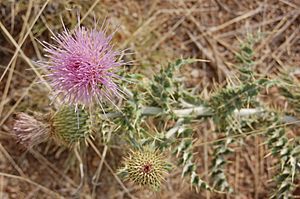New Mexico thistle facts for kids
Quick facts for kids New Mexico thistle |
|
|---|---|
 |
|
| Scientific classification | |
| Genus: |
Cirsium
|
| Species: |
neomexicanum
|
The New Mexico thistle (scientific name: Cirsium neomexicanum) is a type of thistle plant found in North America. It's also known by fun names like powderpuff thistle or desert thistle.
This plant grows naturally in the southwestern United States and northwestern Mexico. You can find it in places like the Mojave and Sonoran Deserts. It has been seen in California, Nevada, Arizona, Sonora, Utah, Colorado, New Mexico, and Texas.
Contents
What Does the New Mexico Thistle Look Like?
The New Mexico thistle is a very tall plant. It often grows more than 2 meters (about 6.5 feet) high. Its stem stands straight up and might have soft, web-like fibers. It also has long, stiff spines.
Leaves and Spines
The leaves of this thistle are a greenish-gray color. They are not very dense on the stem. The leaves are also quite hairy and have many sharp spines.
Flowers and Blooms
At the top of the mostly bare stems, you'll find one or more large flower heads. These flower heads have round bases. They are covered in special leaf-like parts called phyllaries. These phyllaries have long, curving spines.
The biggest flower heads can be up to 5 centimeters (2 inches) wide. They are filled with many small white or lavender flowers. These tiny flowers are called disc florets. Unlike some other flowers, this thistle does not have ray florets, which are the petal-like parts you see on a daisy.
Seeds and Spreading
After the flowers bloom, the plant produces fruit. The fruit is a flat, brown seed called an achene. Each achene has a long, feathery attachment called a pappus. This pappus can be up to 2 centimeters long. It helps the seeds float away in the wind.
Unlike many other types of thistles, the New Mexico thistle usually doesn't cause problems. It is not considered a harmful noxious weed that spreads too much.
See also
 In Spanish: Cirsium neomexicanum para niños
In Spanish: Cirsium neomexicanum para niños

